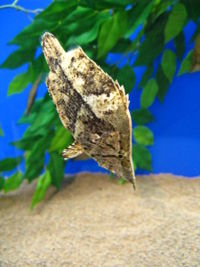Leaf Fish (Monocirrhus polyacanthus)
From The Aquarium Wiki
(Redirected from South American Leaf Fish)
Monocirrhus polyacanthus
95 Litres (25 US G.)
7-8 cm (2.8-3.1")
Freshwater
5.0 - 6.0
22 -25 °C (71.6-77°F)
5-8 °d
1:1 M:F
5-8 years
Family
Polycentridae
Contents
Additional names
- Leaf Fish, Amazon Leaffish, South American Leaf Fish
Additional scientific names
- Monocirrhus mimophyllus
Sexing[edit]
- Mature females will appear rounder in the belly during spawning season, but otherwise they are difficult to visually sex.
Tank compatibility[edit]
- They do well with bottom dwelling fish, such as Corydoras and fish that are too large to be eaten, yet are not boisterous and not won't bother the fish.
Diet[edit]
- Most will reject flake foods, thus, one must be prepared with live foods before purchasing a specimen. Young guppies make excellent food, and live river shrimp, ghost shrimp, brine shrimp and bloodworms as a supplement. It is recommended to gut-load food such as the shrimp before feeding it to the fish, so that it will have higher nutritional value.
Feeding regime[edit]
- Usually every 4-5 days for older specimens, should not be fed another fish that is too big, as, it will have difficulty catching them.
Environment specifics[edit]
- These fish need good-sized mature tanks with dense vegetation and they do not appreciate bright lighting to benefit from floating plants also, as well as dark substrate. They are best kept in a tank that replicates their natural environment with tank-safe leaves, twigs and branches.
Behaviour[edit]
- They inhabit most tank levels, but primarily stay in mid-water. A rather laid back species, doesn't enjoy boisterous fish, highly predatory, and should not be trusted with fish small enough to be swallowed.
Identification[edit]
- An oval fish with a large mouth with a pointed lower jaw. The colouration can vary depending on the environment, they are usually orange-yellow to brown with various markings giving this species the appearance of a dead leaf. A transverse line runs through the eye to the belly, while another runs from the mouth, through the eye and to the caudal fin. The third line runs from the eye to first rays of the dorsal fin. The anal and dorsal fins are long and edged with light coloured spines, also adding to the camouflage of a dead leaf.
Pictures[edit]
Videos[edit]
| In the wild: |
External links[edit]
- Fishbase (Mirrors:
 )
)
